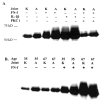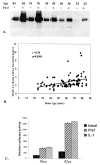Increased matrix metalloproteinase-13 production with aging by human articular chondrocytes in response to catabolic stimuli
- PMID: 16183949
- PMCID: PMC1482465
- DOI: 10.1093/gerona/60.9.1118
Increased matrix metalloproteinase-13 production with aging by human articular chondrocytes in response to catabolic stimuli
Abstract
Chondrocyte anabolic activity has been shown to decline with aging, but catabolic activity has received little attention. In this study, the effect of aging on the chondrocyte catabolic response was determined by stimulating isolated human chondrocytes with fibronectin fragments (FN-f) or interleukin-1beta and measuring matrix metalloproteinase-13 (MMP-13) production as a catabolic response. A significant age-related increase in chondrocyte MMP-13 production was noted. FN-f stimulation of MMP-13 expression was blocked using a nuclear factor kappa-B (NFkappaB) inhibitor suggesting a role for NFkappaB in this chondrocyte catabolic response. Chondrocyte production of the NFkappaB-regulated cytokine interleukin-1beta was also found to increase with donor age in unstimulated cells. These results demonstrate a significant age-related increase in chondrocyte catabolic responsiveness which could contribute to the development of osteoarthritis in older adults.
Figures





References
-
- Loeser RF, Shakoor N. Aging or osteoarthritis: which is the problem? Rheum Dis Clin North Am. 2003;29:653–673. - PubMed
-
- Finkel T, Holbrook NJ. Oxidants, oxidative stress and the biology of ageing. Nature. 2000;408:239–247. - PubMed
-
- Allen RG, Tresini M. Oxidative stress and gene regulation. Free Radic Biol Med. 2000;28:463–499. - PubMed
-
- Goldring MB. The role of the chondrocyte in osteoarthritis. Arthritis Rheum. 2000;43:1916–1926. - PubMed
Publication types
MeSH terms
Substances
Grants and funding
LinkOut - more resources
Full Text Sources
Medical
Miscellaneous

